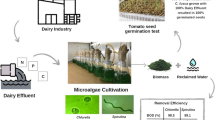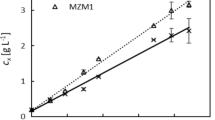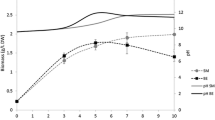Abstract
Water security may be regarded as a first step toward achieving food and energy security. Efficient use of fresh water resources and recycling of wastewater after proper treatment are viewed as tools to achieve water sustainability. Sugar industry can have good potential to treat and reuse its effluents. This potential is not realized by prevailing effluent treatment technologies because of high capital and operation cost of treatment process. More upon, these technologies require substantial amount of energy (electricity) as well as chemicals and labors. We have therefore focused on the development of a technology that would help to overcome these limitations. The alga—Spirulina—was our choice to (1) treat the effluent and (2) use the sugar mill effluent as its growth medium. Experiments using Spirulina at secondary treatment stage showed 91 % reduction in chemical oxygen demand in 108-h treatment time. Further, biochemical analysis of Spirulina harvested from the sugar mill effluent treatment tanks revealed that the harvested biomass has high protein levels. Spirulina is well known for its usage as a protein supplement and therefore can be used as an additional source of revenue generation.




Similar content being viewed by others
References
Avila-Leon I, Chuei Matsudo M, Sato S, de Carvalho JCM (2012) Arthrospira platensis biomass with high protein content cultivated in continuous process using urea as nitrogen source. J Appl Microbiol 112:1086–1094
Benemann JR (1979) Production of nitrogen fertilizer with nitrogen-fixing blue-green algae. Enzyme Microb Technol 1:83–90
Bigas H (ed) (2012) The global water crisis: addressing an urgent security issue. Papers for the InterAction Council, 2011–2012. Hamilton, Canada: The United Nations University—Institute for Water, Environment and Health (UNU-INWEH)
Central Pollution Control Board (2003) Charter on corporate responsibility for environmental protection
Ciferri O (1983) Spirulina, the edible microorganism. Microbiol Rev 47(4):551–578
Costa JAV, Colla LM, Filho PD (2003) Spirulina platensis growth in open raceway ponds using fresh water supplemented with carbon, nitrogen and metal ions. Z Naturforsch 58c:76–80
De-Bashan LE, Bashan Y (2010) Immobilized microalgae for removing pollutants: review of practical aspects. Bio-resour Technol 101:1611–1627
Deshmane A, Nimbalkar D, Nikam TD, Ghole VS (2015) Exploring alternative treatment method for sugar industry effluent using ‘Spirulina platensis’. Sugar Tech. doi:10.1007/s12355-015-0366-1
Eaton AD, Clesceri LS, Rice EW, Greenberg AE (eds) (2005) Standard methods for the examination of water and wastewater. American Public Health Association (APHA), American Water Works Association (AWWA) and Water Environment Federation (WEF), Washington, DC
Green FB, Lundquist TJ, Oswald WJ (1995) Energetics of advanced integrated wastewater pond system. Water Sci Technol 31(12):9–20
Hori K, Ishii S, Ikeda G, Okamoto J, Tanji Y, Weeraphasphong C (2002) Behavior of filamentous cyanobacterium Anabaena spp. in water column and its cellular characteristics. Biochem Eng J 10:217–225
Lavens P, Sorgeloos P (eds) (1996) Manual on the production and use of live food for aquaculture. Food and Agriculture Organization (FAO) fisheries technical paper 361. FAO, Rome
Lowry OH, Rosebrough NJ, Farr AL, Randall RJ (1951) Protein measurement with the Folin phenol reagent. J Biol Chem 193:265–275
Mara DD (2006) Natural wastewater treatment; good practice in water and environmental management. In: Nigel Horan (ed) Aqua Enviro Technology Transfer, Wakefield
Marquez Facundo J, Sasaki Ken, Kakizono Toshihide, Nishio Naomichi, Nagap Shiro (1993) Growth characteristics of Spirulina platensis and in mixotrophic and heterotrophic conditions. J Ferment Bioeng 76(5):408–410
Ogawa T, Terui G (1970) Studies on the growth of Spirulina platensis. (I) On the pure culture of Spirulina platensis. J Ferment Technol 48:361–367
Ogawa T, Terui G (1972) Growth kinetics of Spirulina platensis in autotrophic and mixotrophic cultures. In: Terui G (ed) Fermentation technology today. Society of Fermentation Technology, Tokyo, pp 543–549
Ogbonda KH, Aminigo RE, Abu GO (2007) Influence of temperature and pH on biomass production and protein biosynthesis in a putative Spirulina sp. Bio-resource Technol 98:2207–2211
Oswald WJ (2003) My sixty years in applied algology. J Appl Phycol 15:99–106
Pedroni P, Davison J, Beckert H, Bergman P, Benemann J (2001) A proposal to establish an international network on biofixation of CO2 and greenhouse gas abatement with microalgae. J Energy Environ Res 1:136–150
Phang SM, Miah MS, Yeoh BG, Hashim MA (2000) Spirulina cultivation in digested sago starch factory wastewater. J Appl Phycol 12:395–400
Rajagopal R, Noori M, Saady Cata, Torrijos M, Thanikal JV, Hung YT (2013) Sustainable agro-food industrial wastewater treatment using high rate anaerobic process. Water 5:292–311
Ramkrishan K, Srirama CM, Thamizhin IP, Sundar MP (2001) Effect of sugar mill effluent polluted soil on VAM fungi. J Ecobiol B(3):187–192
Sassano CEN, Gioielli LA, Ferreira LS, Rodrigues MS, Sato S, Converti A (2010) Evaluation of the composition of continuously-cultivated Arthrospira (Spirulina) platensis using ammonium chloride as nitrogen source. Biomass Bioenergy 34:1732–1738
Upadhyay RN, Pandey VC, Tewari DD, Verma SC, Pandey K (2009) Study of the groundwater quality contaminated with sugar mill effluent. Nat Environ Pollut Technol 7:249–252
Uslu L, Isik O, Koç K, Göksan T (2011) The effects of nitrogen deficiencies on the lipid and protein contents of Spirulina platensis. Afr J Biotechnol 10(3):386–389
Vonshak A, Tomaselli L (2003) Arthrospira (Spirulina): systematics and ecophysiology biochemistry. In: Vonshak A (ed) Spirulina platensis (Arthrospira): physiology, cell-biology and biotechnology. Taylor & Francis, London, pp 505–522
Wu JF, Pond WG (1981) Amino acid composition and microbial contamination of Spirulina maxima, a blue-green alga, grown on the effluent of different fermented animal wastes. Bull Environ Contam Toxicol 27:151–159
Acknowledgments
We thank Vasantdada Sugar Institute for funding the present research, Dr Latey for his guidance to improve the language of the manuscript and the following industries for providing effluent used in this study: Yashwant Sahakari Sakhar Karkhana Limited, Theur, District Pune, Maharashtra; Sant Tukaram Sahakari Sakhar Karkhana Limited, Kasarsai-Darumbre, District Pune, Maharashtra; Shri Nath Mhaskoba Sahakari Sakhar Karkhana Limited, Rahu, Daund District Pune, Maharashtra.
Author information
Authors and Affiliations
Corresponding author
Rights and permissions
About this article
Cite this article
Deshmane, A.B., Darandale, V.S., Nimbalkar, D.S. et al. Sugar mill effluent treatment using Spirulina for recycling of water, saving energy and producing protein. Int. J. Environ. Sci. Technol. 13, 749–754 (2016). https://doi.org/10.1007/s13762-015-0891-1
Received:
Revised:
Accepted:
Published:
Issue Date:
DOI: https://doi.org/10.1007/s13762-015-0891-1




